by tmoffett | Aug 3, 2010 | Black and White, Landscape, Photographic Philosophy
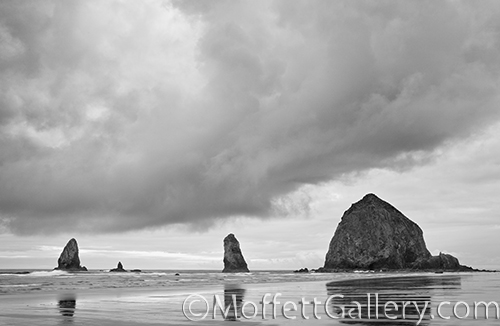
Haystack Rock and The Needles, Cannon Beach, OR
Of all the days that I have been at Cannon Beach, there has only been one time that there was no haze. It was wonderful. Clear and an approaching storm, I could not have asked for more. Perfect lighting for black and white, which is my favorite medium to work in. I know, with all of the color images that I have been posting, that is hard to believe, but when I conditions are really there for black and white, I feel as though I am in heaven!
I learned black and white in the old days, with film and the Zone System. I still look at it the same. I must be able to get the tonal range correct. There is no faking it. For a quality image it must be captured correctly in camera and then post processing done to perfection. It is not easy but it is always worth the effort. When someone mistakes a digital image for one done with film and a darkroom I know it is perfect.
This is one of my favorite images of Haystack Rock. As the tide was receding it left the saturated sand that reflected the image of the rock very nicely. As I set up and watched the scene unfold, the clouds began rolling in, and with a few minor shifts of the camera position I was able to place this cloud in perfect position. Swooping across the image just above the Needles and Haystack as if trying to get over them without touching. I watched as the waves lapped at the base of the rocks, the storm came and went, it was awesome. The scene was speaking to me. If we decide where we are going, what we want out of life, then dig in solidly and when winds and waves of life attack we will not be moved.
by tmoffett | Aug 2, 2010 | Color, Composition, Landscape
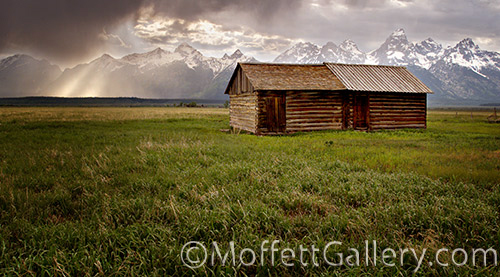
Texture in the Tetons
Texture is an interesting element. It creates detail in a picture that we like to explore. It can create interest where it might otherwise be boring. It can also create busyness that can be a distraction if misused. Simple composition packed with texture is most effective.
I happen to be fortunate to be at the base of the Tetons one evening during some stormy weather. The clouds lifted just enough for the suns rays to penetrate and create just enough illumination for near perfect balance between the foreground and background. The rays themselves make an interesting secondary subject on the left side of the image as well. The light quality is very important, but look at the texture here as well. we have three different kinds of texture at play. First, the foreground, the grasses and foliage are all texture, leading the eye to the log structure which is number 2. Due to its being nearly surrounded by the foreground and its different type of texture, the eye finds it as a resting place. Having a resting place is essential in an image packed with texture, otherwise we bounce from one thing to another and it becomes exhausting to look at.
Our third element of texture is the mountains themselves. By being backlit, the contrast is reduced and the mountains become less dominant, the perfect background. this image is not so much about the the building or the mountains, but more about light and texture, visually a great combination.
by tmoffett | Jul 31, 2010 | Color, Landscape, Photographic Philosophy, Uncategorized
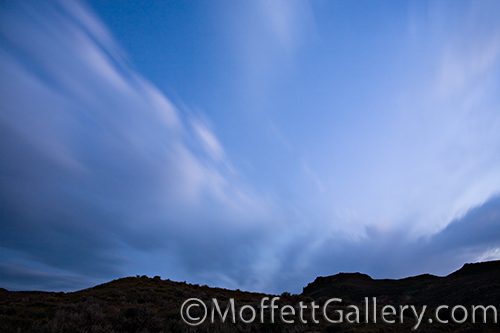
Midnight Sky
I know I have mentioned this before, but so many times we put our cameras away too early in the evening. I am amazed at how interesting images can made long after the sun has set. I love the quality of light just after sunset, but will often continue to explore with my camera deep into the night.
This image was made late one night while on a camping trip with one of my sons boy scout troop. We had eaten a late dinner and the boys were playing some games and so I decided to wander off to photograph. The sun had long since descended below the horizon and the moon was hidden behind some thick clouds in the eastern sky. I focused my camera on the southern horizon and watched the clouds as they moved in. A long exposure (30 seconds) was needed to brighten the sky, yet the mountains still remained nearly silhouetted. There is just a touch of detail in the final print, although it doesn’t show up well in this low res file. The movement of the clouds, to me is very intriguing. The light enhances the feel, as it almost appears to be lit from within. There is a glow, or a luminescence within the image creating a magical feeling. Something very difficult to re-create during the daytime hours.
Being out in the wilderness in the crisp night air, listening to the coyotes howl and making photographs, what else could more refreshing? Shooting at night can be a creatively enhancing experience. It certainly was for me this night.
by tmoffett | Jul 29, 2010 | Color, Composition, Landscape
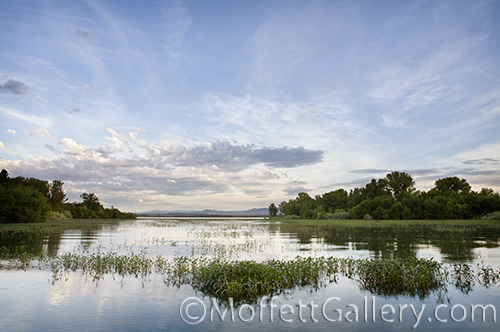
Reflections
The illusion of three dimensionality in a photograph can be powerful. It pulls the viewer into the image and lets him/her roam around. You feel as though you are there, the scene unfolding right before your eyes. Lack of the illusion of depth and all you have is a piece of paper. Not too exciting to look at.
One effective method of creating depth in a landscape photograph is by using the concept of perspective, making sure that there are foreground, mid-ground and background elements in the image. These elements, when working together will capture your attention and then draw you in, allowing you to explore the scene as if you were really there. When I see an image with good use of perspective, creating depth, I often find myself wanting to examine every square millimeter of the photograph. It makes me feel as though I were there, and creating feeling is what photography is all about, at least for me.
by tmoffett | Jul 28, 2010 | Color, Landscape, Photographic Philosophy
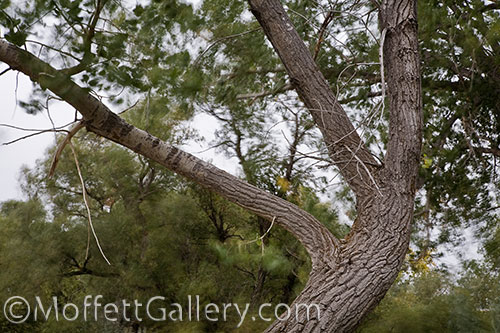
Wind Blown
With portraits, I hated windy days. I didn’t mind the rain, but wind made life very difficult to work with. In my landscape work, however, I have been shooting in the wind quite a bit. I have been intrigued with motion for some time now. A windy day is now perfect!
Using a tripod, I can capture objects that are firm and strong, and they remain still and sharp, while smaller objects, like leaves on a tree, or plants, flowers and grasses blur from their motion. It can create very interesting images. The movement and flow helps to create mood, feeling and meaning, the very need for successful images.
by tmoffett | Jul 27, 2010 | Color, Composition, Landscape, Photographic Philosophy
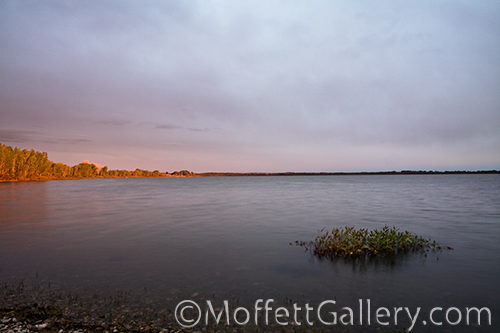
Silence
A photograph that has no emotional impact is just a pretty picture. I have made a lot of pretty pictures in my life, but I hope that I have also created my share of meaningful images. I love photography. I love nature. Photographing is what I have always done and I will continue to do throughout my life. I got my first camera when I was about 8 years old and the journey began. At that time I made a lot of snapshots. I was documenting my life. My vision has changed and now I shoot to create images of what I feel. I search for meaning in my images. I often find myself in my photographs. Not physically, but emotionally.
This particular image makes me feel something. It has a darker tonal range, yet the sky maintains some bright tones and has a sense of mystic about it. The dominance of cool colors and a few warm reflections from the setting sun scattered throughout. A world turned upside down with a few feelings of hope scattered about. It is about searching, reaching for something better, improving oneself, progressing. The composition supports this train of thought as you move from the rocks on the shore to the plants in the water to the trees reflecting the light from the setting sun and then progressing into the eeriness of the stormy sky.
I don’t often talk about what my images say or mean to me, as I like to let the viewer decide for themselves what the meaning is. Know this, though, that I am always photographing from the heart. I am passionate about what I do. I lose myself while photographing and often do not see the meaning right away. It is after the image is completed and I look into it and find myself, my thoughts and feelings, speaking quietly to my heart. This is how I work. This is me.








Recent Comments